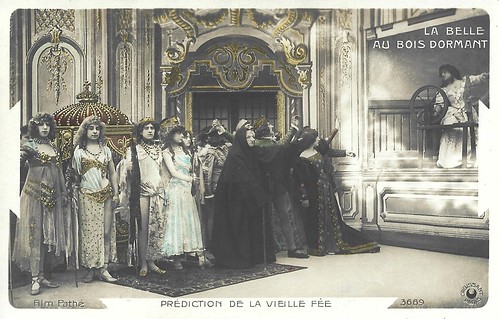
French postcard by Croissant, Paris, no. 3669. Photo: Pathé Frères. Scene from La belle au bois dormant/The Sleeping Beauty (Lucien Nonguet, Ferdinand Zecca, 1902). Caption: Prédiction de vieille fée (The prediction of the old fairy).

French postcard by Croissant, Paris, no. 3669. Photo: Pathé Frères. Scene from La belle au bois dormant/The Sleeping Beauty (Lucien Nonguet, Ferdinand Zecca, 1902). Caption: Que c'est joli, une quenouille! (How nice, a spinning wheel!).
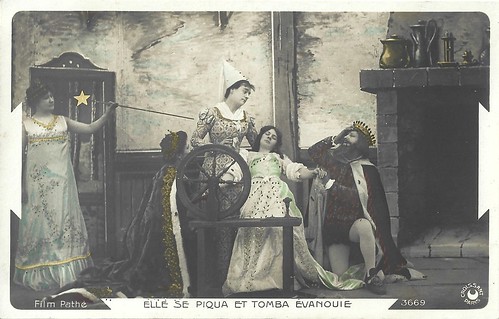
French postcard by Croissant, Paris, no. 3669. Photo: Pathé Frères. Scene from La belle au bois dormant/The Sleeping Beauty (Lucien Nonguet, Ferdinand Zecca, 1902). Caption: Elle se piqua et tomba évanouie (She pricked herself and fell down unconscious).

French postcard by Croissant, Paris, no. 3669. Photo: Pathé Frères. Scene from La belle au bois dormant/The Sleeping Beauty (Lucien Nonguet, Ferdinand Zecca, 1902). Caption: Le sommeil durera cent ans (The sleep will last for a hundred years).
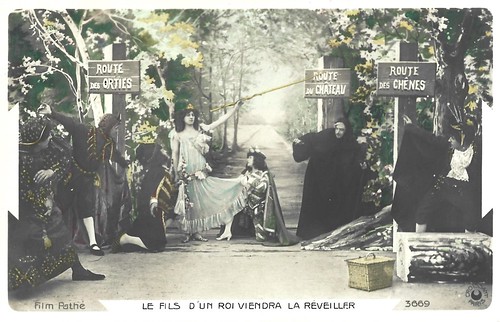
French postcard by Croissant, Paris, no. 3669. Photo: Pathé Frères. Scene from La belle au bois dormant/The Sleeping Beauty (Lucien Nonguet, Ferdinand Zecca, 1902). Caption: Le fils d'un roi viendra la réveiller (The son of a king will wake her up).
A princess cursed by an evil fairy
La belle au bois dormant/The Sleeping Beauty (Lucien Nonguet, Ferdinand Zecca, 1902) was based on the classic fairy tale by Charles Perrault. 'Sleeping Beauty' or 'The Sleeping Beauty in the Woods' or in French 'La belle au bois dormant' is a fairy tale about a princess cursed by an evil fairy. Perrault calls her "Carabosse". The Princess goes to sleep for a hundred years before being awakened by a handsome prince. A good fairy, knowing the princess would be frightened if alone when she wakes, uses her wand to put every living person and animal in the palace and forest asleep, to wake when the princess does.
The earliest known version of the tale is found in the narrative 'Perceforest', written between 1330 and 1344. Another version was published by Giambattista Basile in his collection titled 'The Pentamerone' published posthumously in 1634. Charles Perrault adapted it in 'Histoires ou contes du temps passé' in 1697. The Brothers Grimm included a variant of 'Sleeping Beauty', called 'Dornröschen', in their collection (1812). The version collected and printed by the Brothers Grimm was one orally transmitted from the Perrault version.
Originally, the Perrault tale had a second part in which, years after, the prince has become king and is away. Meanwhile, his mother, who proves to be an ogress, wants to eat the two young royal children Aurore (Dawn) and Jour (Day), and eventually the young mother too, but the cook repeatedly manages to mislead the ogress. When the fraud is discovered, the Queen Mother wants to kill the cook in a tub filled with vipers and other terrible creatures. The king returns just in time and the ogress is thrown in the tub instead. The Grimm brothers used this extension only in an early version of their tale, omitting it afterwards. Most film versions omitted this gruesome part too.
The 1902 Pathé Frères version by Lucien Nonguet and Ferdinand Zecca was probably the oldest film version of the tale. It is unknown who the actors were. Pathé did a remake in 1908, for which the directors, Lucien Nonguet and Albert Capellani, shot the exteriors at the castle of Pierrefonds. This version can easily be found on the net. Many other film versions would follow, of which Disney's Sleeping Beauty (Clyde Geronomi et.al., 1959) may be the best-known one.
In 2005 a German-titled print of the film from the Film Archiv Austria was shown at the Il Cinema Ritrovato festival in Bologna. Mariann Lewinsky wrote in the festival catalogue: "The importance of fairytale films in the production of the time can probably be explained by the fact that children were a very important audience: It was not in dramas and acrobatic films that I put my best hope. It was in fairytales. I made many of them, for children… (Ferdinand Zecca, as quoted by Bousquet)." In 2009 an English-titled print from the National Film and Sound Archive, Australia, was shown at the Giornate del Cinema Muto in Pordenone.
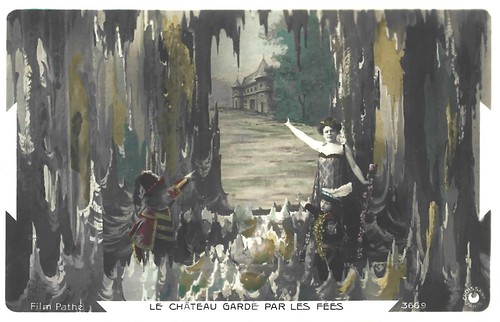
French postcard by Croissant, Paris, no. 3669. Photo: Pathé Frères. Scene from La belle au bois dormant/The Sleeping Beauty (Lucien Nonguet, Ferdinand Zecca, 1902). Caption: Le château gardé par les fées (The castle garded by the fairies).

French postcard by Croissant, Paris, no. 3669. Photo: Pathé Frères. Scene from La belle au bois dormant/The Sleeping Beauty (Lucien Nonguet, Ferdinand Zecca, 1902). Caption: Le prince se mit à genoux (The prince kneeled down).
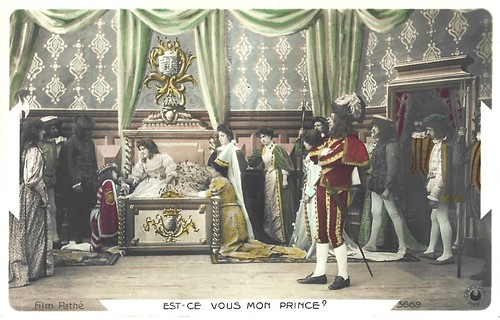
French postcard by Croissant, Paris, no. 3669. Photo: Pathé Frères. Scene from La belle au bois dormant/The Sleeping Beauty (Lucien Nonguet, Ferdinand Zecca, 1902). Caption: Est-ce vous, mon prince? (Is it you, my Prince?).

French postcard by Croissant, Paris, no. 3669. Photo: Pathé Frères. Scene from La belle au bois dormant/The Sleeping Beauty (Lucien Nonguet, Ferdinand Zecca, 1902). Caption: La bonne fée réveillant le palais (The good fairy waking up the palace).

French postcard by Croissant, Paris, no. 3669. Photo: Pathé Frères. Scene from La belle au bois dormant/The Sleeping Beauty (Lucien Nonguet, Ferdinand Zecca, 1902). Caption: Et la dame d'honneur tira le rideau (And the lady-in-waiting lifted the curtain). The image establishes the typical apotheosis of many early fairy-tale films by Pathé and its contemporaries.
Sources: Il Cinema Ritrovato, Cineteca del Friuli and Wikipedia.
No comments:
Post a Comment